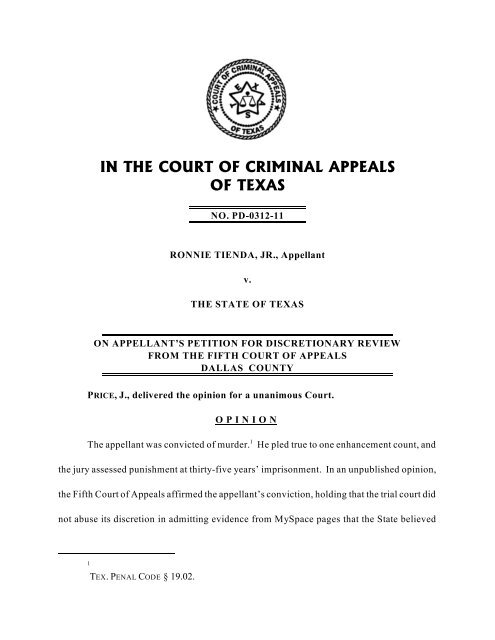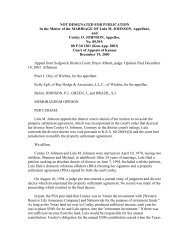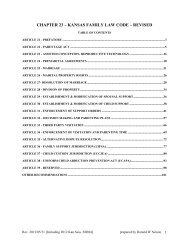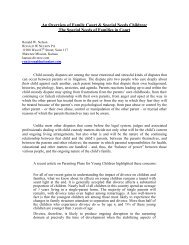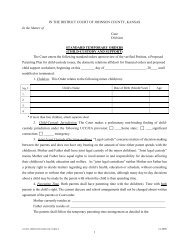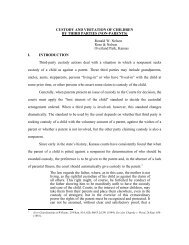Tienda v. State - Court of Criminal Appeals
Tienda v. State - Court of Criminal Appeals
Tienda v. State - Court of Criminal Appeals
Create successful ePaper yourself
Turn your PDF publications into a flip-book with our unique Google optimized e-Paper software.
<strong>Tienda</strong> — 5tattoos and making gang-related gestures with his hands.The main pr<strong>of</strong>ile pages <strong>of</strong> the MySpace accounts contained quotes boasting “You aintBLASTIN You aint Lastin” and “I live to stay fresh!! I kill to stay rich!!” Under the heading“RIP David Valadez” was a link to a song that was played by Valadez’s cousin at Valadez’sfuneral. Another music link posted to one <strong>of</strong> the pr<strong>of</strong>iles was a song titled “I Still Kill.” Theinstant messages exchanged between the account holder and other unidentified MySpaceusers included specific references to other passengers present during the shooting,circumstances surrounding the shooting, and details about the <strong>State</strong>’s investigation followingthe shooting. The author <strong>of</strong> the messages made specific threats to those who had been“snitchin” and “dont run shit but they mouth,” assigning blame to others for being the “onlyreason im on lock down and have this shit on my back.” The author also generally boastedto another user that “WUT GOES AROUND COMES AROUND” and “U KNO HOW WEDO, WE DON’T CHASE EM WE REPALCE EM.” The author accused: “EVERYONEWUZ BUSTIN AND THEY ONLY TOLD ON ME.” Several <strong>of</strong> the instant messages alsocomplained about the author’s electronic monitor, which was a condition <strong>of</strong> the appellant’s5house arrest while awaiting trial.The <strong>State</strong> elicited additional testimony concerning the MySpace pages through aDallas Police Department gang unit <strong>of</strong>ficer, Detective Daniel Torres, during guilt/innocence5All quotes are as they appear in <strong>State</strong>’s Exhibit 94, which contains printouts <strong>of</strong> messagesbetween one <strong>of</strong> the MySpace accounts that the <strong>State</strong> asserted belonged to the appellant and variousother unidentified MySpace users.
<strong>Tienda</strong> — 6and through Valadez’s mother during punishment. The <strong>of</strong>ficer testified regarding thecommon use <strong>of</strong> social networking media, such as MySpace, by gangs to stay in touch withmembers and to “promote” their gangs by bragging about participation in gang-relatedactivities. At punishment, Valadez’s mother was permitted to testify about how “devastated”she and her family were when they found the appellant’s music link on his pr<strong>of</strong>ile page withthe title “RIP David Valadez,” which in her eyes was the appellant’s way <strong>of</strong> bragging aboutkilling her son through the song that was played at his memorial. The appellant repeatedlyobjected, during both stages <strong>of</strong> trial, on the basis <strong>of</strong> improper authentication, hearsay, andrelevance.Through cross examination <strong>of</strong> Palomo, defense counsel elicited testimony regardingthe ease with which a person could create a MySpace page in someone else’s name and thensend messages, purportedly written by the person reflected in the pr<strong>of</strong>ile picture, withouttheir approval. Defense counsel emphasized that any case-specific facts that were referencedin the MySpace messages associated with these accounts were not facts solely within thedefendant’s knowledge, but were known to the deceased’s family, friends, and practically anyother third party interested in the case. Although the gang <strong>of</strong>ficer, Torres, testified to havingprior experience using MySpace to investigate gang-related activity, when asked on crossexamination whether he had any particular knowledge regarding how a MySpace account iscreated, he stated: “None, whatsoever.” The <strong>of</strong>ficer acknowledged that anyone could createa MySpace page, but he had never created one himself.
<strong>Tienda</strong> — 8petition for discretionary review to determine whether the court <strong>of</strong> appeals erred in holdingthat the trial court did not abuse its discretion in finding that the MySpace pr<strong>of</strong>iles wereproperly authenticated. We now affirm.THE ARGUMENTS AND THE LAW OF AUTHENTICATIONThe Arguments <strong>of</strong> the PartiesIn his only issue for discretionary review, the appellant contends that the trial courterred in admitting into evidence the electronic content obtained from MySpace during boththe guilt/innocence and punishment phases <strong>of</strong> his trial. The appellant broadly argues thatthe <strong>State</strong> failed to properly authenticate any <strong>of</strong> the evidence printed from the socialnetworking website; and more specifically, that the “contents <strong>of</strong> a website cannot8authenticate the website” itself. In other words, he complains that the <strong>State</strong> did not provethat he was responsible for creating and maintaining the content <strong>of</strong> the MySpace pages bymerely presenting the photos and quotes from the website that tended to relate to him.Therefore, the appellant concludes, the trial court erred in overruling his running objections9under Texas Rules <strong>of</strong> Evidence Rule 901, and the court <strong>of</strong> appeals should not have affirmed<strong>Appeals</strong> <strong>of</strong> Maryland, Griffin v. <strong>State</strong>, 192 Md. App. 518, 995 A.2d 791 (2010), whileacknowledging that the Maryland <strong>Court</strong> <strong>of</strong> <strong>Appeals</strong> had since granted discretionary review. <strong>Tienda</strong>,supra, at *5. The Maryland <strong>Court</strong> <strong>of</strong> <strong>Appeals</strong> subsequently reversed the judgment <strong>of</strong> the <strong>Court</strong> <strong>of</strong>Special <strong>Appeals</strong> <strong>of</strong> Maryland, in Griffin v. <strong>State</strong>, 419 Md. 343, 19 A.3d 415 (2011).89Appellant’s Brief, at 5.TEX. R. EVID. 901.
<strong>Tienda</strong> — 9its ruling.The <strong>State</strong> contends, in opposition, that the contents <strong>of</strong> the social networking pages inthis case contained sufficiently distinctive information to justify conditionally submittingthem to the jury for its ultimate finding whether “the matter in question is what its proponent10claims” —here, that the MySpace pages were created and maintained by the appellant. Thespecificity <strong>of</strong> the content, which the <strong>State</strong> characterized as “admissions” by the appellant, wassufficient to tie him to this particular evidence and allow the jury to consider it for that11purpose. At a minimum, the <strong>State</strong> argues, the trial court’s decision was “within the zone<strong>of</strong> reasonable disagreement” and therefore should not be disturbed on appeal. 12Standard <strong>of</strong> Review and Applicable LawUnder Texas Rules <strong>of</strong> Evidence Rule 104(a), whether or not to admit evidence at trial13is a preliminary question to be decided by the court. A bedrock condition <strong>of</strong> admissibility<strong>of</strong> evidence in any legal contest is its relevance to an issue in the case—that is to say, itstendency to make a fact <strong>of</strong> consequence to determination <strong>of</strong> the action more or less10Id. 901(a).11<strong>State</strong>’s Brief, at 1.12Id.13TEX. R. EVID. 104(a).
<strong>Tienda</strong> — 1014probable. Evidence has no relevance if it is not authentically what its proponent claims itto be.Rule 901(a) <strong>of</strong> the Rules <strong>of</strong> Evidence defines authentication as a “conditionprecedent” to admissibility <strong>of</strong> evidence that requires the proponent to make a thresholdshowing that would be “sufficient to support a finding that the matter in question is what its15proponent claims.” Whether the proponent has crossed this threshold as required by Rule16901 is one <strong>of</strong> the preliminary questions <strong>of</strong> admissibility contemplated by Rule 104(a). Thetrial court should admit pr<strong>of</strong>fered evidence “upon, or subject to the introduction <strong>of</strong> evidence17sufficient to support a finding <strong>of</strong>” authenticity. The ultimate question whether an item <strong>of</strong>evidence is what its proponent claims then becomes a question for the fact-finder—the jury,18in a jury trial. In performing its Rule 104 gate-keeping function, the trial court itself neednot be persuaded that the pr<strong>of</strong>fered evidence is authentic. The preliminary question for thetrial court to decide is simply whether the proponent <strong>of</strong> the evidence has supplied facts thatare sufficient to support a reasonable jury determination that the evidence he has pr<strong>of</strong>fered14TEX. R. EVID. 401 & 402.15TEX. R. EVID. 901(a).2007).16See TEX. R. EVID. 104(a), 901(a); Druery v. <strong>State</strong>, 225 S.W.3d 491, 502 (Tex. Crim. App.17TEX. R. EVID. 104(b).18Druery, supra.
<strong>Tienda</strong> — 11is authentic. 19Appellate review <strong>of</strong> a trial court’s ruling on such a preliminary question <strong>of</strong>20admissibility is deferential; the standard is abuse <strong>of</strong> discretion. If the trial court’s ruling thata jury could reasonably find pr<strong>of</strong>fered evidence authentic is at least “within the zone <strong>of</strong>21reasonable disagreement,” a reviewing court should not interfere.Evidence may be authenticated in a number <strong>of</strong> ways, including by direct testimonyfrom a witness with personal knowledge, by comparison with other authenticated evidence,22or by circumstantial evidence. <strong>Court</strong>s and legal commentators have reached a virtualconsensus that, although rapidly developing electronic communications technology <strong>of</strong>tenpresents new and protean issues with respect to the admissibility <strong>of</strong> electronically generated,transmitted and/or stored information, including information found on social networking websites, the rules <strong>of</strong> evidence already in place for determining authenticity are at least generally19Id.20Id.21Montgomery v. <strong>State</strong>, 810 S.W.2d 372, 391 (Tex. Crim. App. 1991) (opinion on reh’g).22See TEX. R. EVID. 901(b)(1), (3)-(4) (“(b) Illustrations. By way <strong>of</strong> illustration only, and notby way <strong>of</strong> limitation, the following are examples <strong>of</strong> authentication or identification conforming withthe requirements <strong>of</strong> this rule: (1) Testimony <strong>of</strong> witness with knowledge. Testimony that a matteris what it is claimed to be. * * * (3) Comparison by trier or expert witness. Comparison by the trier<strong>of</strong> fact or by expert witness with specimens which have been found by the court to be genuine. (4)Distinctive characteristics and the like. Appearance, contents, substance, internal patterns, or otherdistinctive characteristics, taken in conjunction with circumstances.”).
<strong>Tienda</strong> — 1223“adequate to the task.” Widely regarded as the watershed opinion with respect to theadmissibility <strong>of</strong> various forms <strong>of</strong> electronically stored and/or transmitted information is24Lorraine v. Markel American Insurance Co. There the federal magistrate judge observedthat “any serious consideration <strong>of</strong> the requirement to authenticate electronic evidence needsto acknowledge that, given the wide diversity <strong>of</strong> such evidence, there is no single approach25to authentication that will work in all instances.” Rather, as with the authentication <strong>of</strong> anykind <strong>of</strong> pr<strong>of</strong>fered evidence, the best or most appropriate method for authenticating electronicevidence will <strong>of</strong>ten depend upon the nature <strong>of</strong> the evidence and the circumstances <strong>of</strong> the23Steven Goode, The Admissibility <strong>of</strong> Electronic Evidence, 29 REV. LITIG. 1, 7 (Fall 2009);see Sandra Hornberger, Comment, Social Networking Websites: Impact on Litigation and the LegalPr<strong>of</strong>ession in Ethics, Discovery, and Evidence, 27 TOURO L. REV. 279, 304-05 (2011) (opining that“the existing evidentiary rules sufficiently address any legal issues surrounding the admission <strong>of</strong>information obtained from social networking websites”); Katherine Minotti, Comment, Evidence:The Advent <strong>of</strong> Digital Diaries: Implications <strong>of</strong> Social Networking Web Sites for the Legal Pr<strong>of</strong>ession,60 S.C. L. REV. 1057, 1074 (“the current federal rules are adequate” to guide courts “when facingevidentiary issues regarding social networking web sites”); Grossman, supra, at 1311 (“judges mayexpress the appropriate skepticism due instant messaging evidence within the framework <strong>of</strong> theRules [<strong>of</strong> Evidence].”); In the Interest <strong>of</strong> F.P., a Minor, 878 A.2d 91, 95 (Pa. 2005) (rejecting theneed to “create a whole new body <strong>of</strong> law just to deal with [the admissibility <strong>of</strong>] e-mails or instantmessages” and opining that “e-mail messages and similar forms <strong>of</strong> electronic communication canbe properly authenticated within the existing framework” <strong>of</strong> the rules <strong>of</strong> evidence); <strong>State</strong> v. Eleck,130 Conn. App. 632, 640, 23 A.3d 818, 823 (2011) (“We agree that the emergence <strong>of</strong> social mediasuch as e-mail, text messaging and networking sites like Facebook may not require the creation <strong>of</strong>new rules <strong>of</strong> authentication with respect to authorship.”).24241 F.R.D. 534 (D. Md. 2007). See also Paul W. Grimm, Michael V. Ziccardi & AlexanderW. Major, Back to the Future: Lorraine v. Markel American Insurance Co. and New Findings onthe Admissibility <strong>of</strong> Electronically Stored Information, 42 AKRON L. REV. 357 (2009).25Lorraine, supra, at 553-54.
<strong>Tienda</strong> — 13particular case. 26Like our own courts <strong>of</strong> appeals here in Texas,27jurisdictions across the country haverecognized that electronic evidence may be authenticated in a number <strong>of</strong> different waysconsistent with Federal Rule 901 and its various state analogs. Printouts <strong>of</strong> emails, internetchat room dialogues, and cellular phone text messages have all been admitted into evidencewhen found to be sufficiently linked to the purported author so as to justify submission to the28jury for its ultimate determination <strong>of</strong> authenticity. Such prima facie authentication has26See, e.g., Druery, supra, at 502-03 (authentication <strong>of</strong> letters); DeLuna v. <strong>State</strong>, 711 S.W.2d44, 46 (Tex. Crim. App. 1986) (photographs); Ex parte Watson, 606 S.W.2d 902, 905 (Tex. Crim.App. 1980) (handwriting comparison).27See, e.g., Manuel v. <strong>State</strong>, ___ S.W.3d ___, No. 12-09-00454-CR, 2011 WL 3837561, at *7(Tex. App.—Tyler Aug. 31, 2011, no pet.) (text messages); Shea v. <strong>State</strong>, 167 S.W.3d 98, 104-05(Tex. App.—Waco 2005, pet. ref’d) (emails); Massimo v. <strong>State</strong>, 144 S.W.3d 210, 215-17 (Tex.App.—Fort Worth 2004, no pet.) (emails).28See Jackson v. <strong>State</strong>, 2009 Ark. App. 466, 320 S.W.3d 13 (2009) (Yahoo instant messageconversations); Bobo v. <strong>State</strong>, 102 Ark. App. 329, 285 S.W.3d 270 (2008) (emails); Hammontreev. <strong>State</strong>, 283 Ga. App. 736, 642 S.E.2d 412 (2007) (internet instant message conversation); Simonv. <strong>State</strong>, 279 Ga. App. 844, 632 S.E.2d 723 (2006) (emails); Ford v. <strong>State</strong>, 274 Ga. App. 695, 617S.E.2d 262 (2005) (internet chat room); <strong>State</strong> v. Glass, 146 Idaho 77, 190 P.3d 896 (on-lineconversation); People v. Chromik, 408 Ill. App.3d 1028, 946 N.E.2d 1039 (2011) (text message);People v. Downin, 357 Ill.App.3d 193, 828 N.E.2d 341 (2005) (email); Commonwealth v. Purdy,459 Mass. 442, 945 N.E.2d 372 (2011) (emails); Commonwealth v. Amaral, 78 Mass. App. Ct. 671,941 N.E.2d 1143 (2011) (emails); Kearley v. <strong>State</strong>, 843 So. 2d 66 (Miss. App. 2002) ( emails);People v. Clevenstine, 68 A.D.3d 1448, 891 N.Y.S.2d 511 (2009) (MySpace instant messages);<strong>State</strong> v. Thompson, 777 N.W.2d 617 (N.D. 2010) (text messages); In the Interest <strong>of</strong> F.P., a Minor,878 A.2d 91 (Pa. 2005) (instant messages); <strong>State</strong> v. Taylor, 178 N.C. App. 395, 632 S.E.2d 218(2006) (text messages); Bloom v. Commonwealth, 262 Va. 814, 554 S.E.2d 84 (2001) (instantndmessages); United <strong>State</strong>s v. Gagliardi, 506 F.3d 140 (2 Cir. 2007) (emails and internet chat room);thUnited <strong>State</strong>s v. Barlow, 568 F.3d 215 (5 Cir. 2009) (Yahoo instant message conversations);thUnited <strong>State</strong>s v. Tank, 200 F.3d 627 (9 Cir. 2000) (internet chat room); United <strong>State</strong>s v. Simpson,thth152 F.3d 1241 (10 Cir. 1998) (internet chat room); United <strong>State</strong>s v. Siddiqui, 235 F.3d 1318 (11
<strong>Tienda</strong> — 14taken various forms. In some cases, the purported sender actually admitted to authorship,29 30either in whole or in part, or was seen composing it. In others, the business records <strong>of</strong> aninternet service provider or a cell phone company have shown that the message originatedwith the purported sender’s personal computer or cell phone under circumstances in whichit is reasonable to believe that only the purported sender would have had access to the31computer or cell phone. Sometimes the communication has contained information that onlyCir. 2000) (email).29Jackson, supra, Ark. App. at 469, S.W.3d at 16 (defendant admitted to police that he hadengaged in instant message conversations and acknowledged transcripts as accurate); Bobo, supra(defendant admitted sending emails, only denying some <strong>of</strong> the content); Simon, supra, Ga. App. at847, S.E.2d at 726 (defendant admitted to two witnesses, including police <strong>of</strong>ficer, that he participatedin the email exchange); Ford, supra, Ga. App. at 697, n.7, S.E.2d at 266, n.7 (defendant gavestatement to police admitting to engaging in the on-line chat); Kearley, supra, at 70 (defendantadmitted to police that he sent emails); Thompson, supra, at 621-22 (defendant’s husband testifiedthat he received text messages from what he knew to be her phone number and that she signed themin a distinctive manner with which he was familiar, and the defendant admitted sending textmessages from her phone to her husband’s phone that day); Bloom, supra, Va. at 821, S.E.2d at 87(defendant admitted to police <strong>of</strong>ficer that he had communicated with instant message recipient onevening in question).30Massimo, supra, at 213 (defendant was “witnessed” to have sent similarly threatening emailto recipient in the past); Clevenstine, supra, A.D.3d at 1450-51, N.Y.S.2d at 514 (“a legalcompliance <strong>of</strong>ficer for MySpace explained that the messages on the computer disk had beenexchanged by users <strong>of</strong> accounts created by defendant and the victims, and defendant’s wife recalledthe sexually explicit conversations she viewed in the defendant’s MySpace account while on theircomputer”).31Bobo, supra, Ark. App. at 335, S.W.3d at 275 (forensic computer expert testified that some<strong>of</strong> the emails “matched a temporary unique IP internet address for” the defendant’s computer);Hammontree, supra, Ga. App. at 739, S.E.2d at 415 (internet message conversation originated fromdefendant’s son’s account, but messages signed by the defendant, he had access to son’s computer,and son denied being author); Chromik, supra, Ill. App. at 1047-48, N.E.2d at 1056-57 (phonerecords show text messages sent from defendant’s phone number at particular date and time alleged,
<strong>Tienda</strong> — 1532the purported sender could be expected to know. Sometimes the purported sender hasresponded to an exchange <strong>of</strong> electronic communications in such a way as to indicatecircumstantially that he was in fact the author <strong>of</strong> the particular communication, the33authentication <strong>of</strong> which is in issue. And sometimes other circumstances, peculiar to thefacts <strong>of</strong> the particular case, have sufficed to establish at least a prima facie showing <strong>of</strong>and defendant admitted sending some <strong>of</strong> them, acknowledging accuracy <strong>of</strong> transcripts); Purdy,supra, Mass. at 450-51, N.E.2d at 381 (emails originated from email account bearing defendant’sname and that he admitted was his, were found on computer he acknowledged was his, and containedinformation about his business that was, if not unique, then at least “unusual”).32Downin, supra, Ill. App. 3d at 195, N.E.2d at 344-45 (victim knew defendant personally, hadexchanged emails with him in the past at an email address she knew to be his, and the email in issuecame from his address, was responsive to an email she had sent him, and “contained information thatwould be known exclusively to” him); Taylor, supra, N.C. App. at 414, S.E.2d at 230-31 (textmessages identified purported sender by name and described car he would be driving on a particularoccasion); Simpson, supra, at 1250 (defendant identified himself by name and email address in thecourse <strong>of</strong> internet chat room communications, and search <strong>of</strong> his home revealed specific writteninformation found next to his computer that had been conveyed to him via those communications);Siddiqui, supra, at 1322-23 (emails purported to come from defendant’s known email address,referred to the author by defendant’s nickname, and contained allusions to events and circumstancesthat only defendant could reasonably be expected to know about).33Shea, supra, at 105 (defendant called recipient to confirm that she had received his email);Glass, supra, Idaho at 82, P.3d at 901 (in on-line conversation, defendant identifies himself by hismiddle name and then appears at a time and place agreed to, and in a car accurately described, in theconversation); Amaral, supra, Mass. App. Ct. at 674, N.E.2d at 1147 (defendant included photo andphone number in emails, which proved to be his, and one email “indicated that [he] would be at acertain place at a certain time, and [he] appeared at that place and time”); Bloom, supra (defendantrevealed his true name and certain biographical information that was accurate, and appeared at thetime and place where he had agreed to meet recipient); Gagliardi, supra, at 143 (defendant showedup at meeting place arranged during the course <strong>of</strong> exchange <strong>of</strong> electronic messages); Barlow, supra,at 218 (defendant arranged via Yahoo instant messages to meet at a state park, and appeared at theappointed place and time, admitting to police that he was there to meet the recipient); Tank, supra,at 630-31 (defendant admitted that screen name used in text messages was his, and witnessestestified that “when they arranged a meeting with the person who used [that screen name], it wasTank who showed up”).
<strong>Tienda</strong> — 16authentication. 34However, mindful that the provenance <strong>of</strong> such electronic writings can sometimes beopen to question—computers can be hacked, protected passwords can be compromised, andcell phones can be purloined—courts in other cases have held that not even the prima facie35demonstration required to submit the issue <strong>of</strong> authentication to the jury has been satisfied.34Manuel, supra, at *8 (text messages originated from phone number that the recipientrecognized to be the defendant’s, from which number she had also received various voice messagesfrom which she recognized the defendant’s voice); In the Interest <strong>of</strong> F.P., a Minor, supra, at 95(instant messages purportedly sent by defendant referenced him by name as the sender, and threatsmade and events discussed therein mirrored animosity that defendant had displaying toward recipientcontemporaneously with the period during which messages were sent).35See People v. Beckley, 185 Cal. App. 4th 509, 518, 110 Cal. Rptr. 3d 362, 368-69 (2010)(purported roster <strong>of</strong> gang members which appeared on a web page printed from the internet was notproperly authenticated where sponsoring police <strong>of</strong>ficer did not know who compiled it and did notexplain the basis for his assertion that the gang itself did so); Eleck, supra, Conn. App. at 642-43,A.3d at 824 (printout <strong>of</strong> instant message exchange from defendant’s Facebook page not properlyauthenticated just because the messages appeared to come from the purported sender’s Facebookaccount; the messages fail to “reflect distinct information that only [the sender] would havepossessed regarding the defendant or the character <strong>of</strong> their relationship”); Hollie v. <strong>State</strong>, 298 Ga.App. 1, 3, 679 S.E.2d 47, 50 (2009) (though email showed on its face that it originated frompurported sender’s email address, “this alone does not prove its genuineness”); Commonwealth v.Williams, 456 Mass. 857, 869, 926 N.E.2d 1162, 1172-73 (2010) (message not properlyauthenticated, even though it came from purported sender’s MySpace page, because “there is notestimony (from [the recipient] or another) regarding how secure such a Web page is, who can accessa MySpace Web page, whether codes are needed for such access, etc.[,]” and also no testimonycircumstantially to “identify the person who actually sent the communication”); People v. Lenihan,30 Misc. 3d 289, 293, 911 N.Y.S.2d 588, 591-92 (2010) (“defendant could not authenticate”photographs taken from a MySpace website because he “did not know who took [them] or postedthem on MySpace”); Commonwealth v. Koch, ___ A.3d ___, 2011 WL 4336634, at *6 (Pa. Super.Ct. 2011) (cell phone text messages require more for authentication “than mere confirmation thatthe number or address belonged to” the purported sender and were inadmissible in the absence <strong>of</strong>“contextual clues in the . . . messages themselves tending to reveal the identity <strong>of</strong> the sender”);thUnited <strong>State</strong>s v. Jackson, 208 F.3d 633, 638 (7 Cir. 2000) (posting on white supremacist group’sinternet web site not authenticated because no showing that the group actually posted it as opposedto the defendant “herself, who was a skilled computer user”); St. Clair v. Johnny’s Oyster & Shrimp,
<strong>Tienda</strong> — 17That an email on its face purports to come from a certain person’s email address, that therespondent in an internet chat room dialogue purports to identify himself, or that a textmessage emanates from a cell phone number assigned to the purported author—none <strong>of</strong> thesecircumstances, without more, has typically been regarded as sufficient to support a finding<strong>of</strong> authenticity. 36ANALYSISIn this case, the internal content <strong>of</strong> the MySpace postings—photographs, comments,and music—was sufficient circumstantial evidence to establish a prima facie case such thata reasonable juror could have found that they were created and maintained by the appellant.That circumstantial evidence included:• The first MySpace business record I.D. is #120841341. The<strong>of</strong>ficial MySpace Subscriber Report lists the User as “FirstName: ron; Last Name: mr.t” with an email address <strong>of</strong>“smileys_shit@.” [Witnesses testified that the appellant’s nicknameis “Smiley.”] The city is listed as “D TOWN.”• The Subscriber Report for MySpace User #300574151 lists theInc., 76 F. Supp. 2d 773, 774-75 (S.D. Texas 1999) (random posting on internet web site cannot beauthenticated because untrustworthy, given that “[a]nyone can put anything on the Internet”).36See Goode, supra, at 10 (“the mere fact that an e-mail bears a particular e-mail address will<strong>of</strong>ten prove inadequate to authenticate the identity <strong>of</strong> the author; typically courts demand at least alittle more evidence”); Purdy, supra, Mass. at 451, N.E.2d at 381 (“Evidence that the defendant’sname is written as the author <strong>of</strong> an e-mail or that the electronic communication originates from ane-mail or social networking Web site such as Facebook or MySpace that bears the defendant’s nameis not sufficient alone to authenticate the electronic communication as having been authored or sentby the defendant.”); Koch, supra, at *6 (“In the majority <strong>of</strong> courts to have considered the question,the mere fact that an e-mail bears a particular e-mail address is inadequate to authenticate the identity<strong>of</strong> the author; typically, court demand additional evidence.”).
owner as “First Name: ron; Last name: Mr. T” with an emailaddress <strong>of</strong> “ronnietiendajr@.” As with the first MySpacelisting, the city for this listing is “D*Town.” The zip code is75212.• The Subscriber Report for MySpace User #435499766 lists theowner as “First Name: SMILEY; Last Name: FACE” with anemail address <strong>of</strong> ronnietiendajr@. The city for this listing is“dallas” and the zip code is 75212.<strong>Tienda</strong> — 18• The first MySpace page <strong>of</strong> User #120841341 <strong>of</strong>fered into37evidence contains a photograph <strong>of</strong> the appellant under the title“SMILEY FACE.” The photograph shows the appellant pullinga shirt up over the bottom half <strong>of</strong> his face. The tattoos on hisarms, however, are clearly visible. There is a date stamp on the38photograph <strong>of</strong> “03/01/2007 17:09.”• To the right side <strong>of</strong> the appellant’s photograph on that MySpacepage is the following:“You aint BLASTIN37Priscilla Palomo, the witness who sponsored the exhibits, identified the MySpacephotographs as being <strong>of</strong> the appellant. Detective Daniel Torres also identified them as being <strong>of</strong> theappellant. The trial judge could also compare the photographs <strong>of</strong> the person on the MySpace pages(during trial they were downloaded from a CD and were in color and enlarged for clarity; that CDis in the appellate record) with the appellant sitting at the defense table. Suffice it to say that theperson in the MySpace photographs has distinctive features and very distinctive tattoos on his body,neck, and arms. In many <strong>of</strong> the photographs, he is wearing the same distinctive glasses and a squareearring. Although some <strong>of</strong> the xeroxed copies <strong>of</strong> the photographs in the reporter’s record are fuzzyand unclear, the ones on the CD are not. One witness, who was at the club with the appellant on thenight <strong>of</strong> the murder, testified that the appellant has the number “18” tattooed on the back <strong>of</strong> his head.One <strong>of</strong> the witnesses in the car with David Valadez, recognized the appellant as the shooter becausehe had the number “18” tattooed on his head. One <strong>of</strong> the MySpace photos shows the appellant withthe number “18” tattooed on his head. Furthermore, one <strong>of</strong> the <strong>State</strong>’s witnesses had alreadyidentified a photograph <strong>of</strong> the appellant and his friend “Nu-Nu” taken on the night <strong>of</strong> DavidValadez’s murder. The appellant’s appearance in that photograph matches his appearance in theMySpace photographs.38David Valadez was murdered on June 25, 2007, about four months later.
<strong>Tienda</strong> — 19You aint Lastin”Male21 years oldD Town, TexasUnited <strong>State</strong>sLast Login: 9/4/2007 39• Below the appellant’s photograph and the caption on thatMySpace page is the legend “RIP David Valadez” and a musicbutton which, according to Priscilla Paloma, played the songthat was played at David Valadez’s funeral.• On the MySpace page for User #300574151, there is aphotograph <strong>of</strong> the appellant, bare-chested, with his gangtattoos—including “Tango Blast” written across his chest. 40• The MySpace page is titled “MR. SMILEY FACE” even thoughthe Subscriber Report list the User’s name as “ron Mr. T” andhis email address as “ronnietiendajr@.”• Beside the appellant’s photograph on that MySpace page is thefollowing:“I LOVE DRAMA SOMUCH CUZ MY LIFEIS SO ROUGH!!!ANYTHING ELSEWOULDN’T SEEMNORMAL!!!39The appellant was 21 on this date. David Valadez was murdered a little more than twomonths earlier.40This photograph is an apparent self-portrait taken with a smart phone in a mirror. DetectiveTorres testified that “Tango Blast” and “NS” referred to a local street gang and that a person withthese tattoos would be a member <strong>of</strong> the gang.
<strong>Tienda</strong> — 20Male22 years oldD*Town, TexasUnited <strong>State</strong>sLast Login: 5/19/2008 41• Below the appellant’s photograph and the caption on thatMySpace page is the music button for the “50 Cent I Still Kill bydj Bali” sound clip.• Below that caption is the following:MR. SMILEY FACE’S INTERESTSGeneral AINT PROUD OF MY PAST BUTIM LIVIN N DA PRESENT NALWAYS PLANIN 4 DA FUTURE!!!NS XV111 ST 42• Also on the MySpace Pr<strong>of</strong>ile page for User #300574151 is alater photograph <strong>of</strong> a bare-chested appellant, again showing histattoo “Tango Blast.” 43• That photograph carries the heading: Mr. ONE OF A KIND.• Beside the appellant’s photograph on that MySpace page is thefollowing:41The appellant was 22 years old as <strong>of</strong> this date.42XVIII is the Roman numeral for 18. Detective Torres testified that the term “NS XV111thST” means the North Side 18 Street, which is a particular “North Side gang located in the GrandPrairie are <strong>of</strong> the metroplex.” The number 18 on the MySpace Page matches the number 18 tattooedon the back <strong>of</strong> the appellant’s head.43This is another apparent self-portrait <strong>of</strong> the appellant taken with a smart phone in a mirror,showing his “Tango Blast” chest tattoo, as well as the tattoos on his arms, posted on the MySpacepage for User #435499766, registered to “SMILEY FACE” with an email address <strong>of</strong>“ronnietiendajr@.”
<strong>Tienda</strong> — 21“DIS IS WHO I AM!!!DON’T LIKE IT FUCKYOU!!!”Male22 years oldD*Town, TexasUnited <strong>State</strong>sLast Login: 9/5/2008 44• On the right hand side <strong>of</strong> the page is the following statement:Mr.ONE OF A KIND I LIVE TO STAY FRESH!! I KILL TOSTAY RICH!! N OTHER WORDS IMA GO TO WAR BOUTMY SHIT!!• The MySpace User #300574151 message page contains45numerous messages to other MySpace users. Only the 53messages sent between 2:00 p.m. and 9:44 p.m. on September21, 2008, were introduced into evidence. The messages thatindicate that it is the appellant himself who is the creator, owner,and user <strong>of</strong> this MySpace account include the following:• At 2:09 p.m. the User sent a message to User #73576314: “SHITCAN U BELIEVE I ALREADY BEEN ON DIS MONITOR AYEAR NOW AND SHIT AINT NO TELLING WHEN ANIGGA GONE GET OFF DIS HOE” 4644The appellant was 22 years old as <strong>of</strong> this date.45Torres, the Dallas gang <strong>of</strong>ficer, testified that gang members frequently communicate witheach other through electronic social media, including MySpace.46According to the Clerk’s Record, the appellant was released on pretrial bond with an anklemonitor on October 24, 2007. One <strong>of</strong> the photographs on the MySpace page for User #435499766(registered to “SMILEY FACE” with an email address <strong>of</strong> “ronnietiendajr@”) is <strong>of</strong> the appellantlounging in a chair with a gold chain hanging down his chest, wearing bright white sneakers and anankle monitor. Another MySpace photograph, associated with User #120841341, shows the
<strong>Tienda</strong> — 22• At 2:17 p.m. the User sent a message to the same User: “SHITIT AINT ME IT THE STATE SETTIN IT OFF AND SINCE IHAVE SNITCHES ON ME THEY TRYNA GET A NIGGALOCKED UP”• Also at 2:17 p.m., the User sent a message to User #103410565:“U KNO ME AND U MY NIGGA SO U WANT TO FUCKHIM UP U KNO HOW WE DO, WE DONT CHASE EM WEREPALCE EM”• At 2:21 p.m. the User sent another message to User#103410565: “IS IT DAT FRIENDLY ASS NIGGA IN ALLDEM PIX AND SHIT JUS PLAY IT COO WUT GOESAROUND COMES AROUND YA FEEL ME”• At 2:22 p.m. the User sent a message to User #73576314:“MAN JESSE BOY HECTOR SNITCHIN ON ME I AINTTRIPPIN ON BEEF BUT TELLIN A WHOLE NOTHERBALL GAME DAT I DONT PLAY”• At 2:27 p.m. the User sent a message to User #12231226: “SHITON STILL ON A MONITOR SO I AINT BEEN NO WHEREIN A BOUT A YEAR NOW AND MY B DAY WAS OTHA12TH U FO GOT BOUT ME” 47• At 2:35 p.m. the User sent a message to User #73576314: “YEAY U THINK IM ON DIS MONITOR MY NIGGA SHITHATIN ASS NIGGAS WNNA TALK ALL DAT GANGSTASHIT AND WEN THE GOIN GET TUFF DEM NIGGASDON’T RUN SHIT BUT THEY MOUTH”• At 2:42 p.m. the User sent a message to the same User: “YEAappellant and two friends “throwing gang signs” in front <strong>of</strong> what appears to be a club with thecaption, “str8 outta jail and n da club.”47A pen packet introduced at the punishment phase <strong>of</strong> trial confirms that the appellant’s date<strong>of</strong> birth is September 12th.
SHIT EVERYONE WUZ BUSTIN AND THEY ONLY TOLDON ME”• At 2:50 p.m. the User sent another message to the same User:“YEA SHIT U KNO I KEEP GANGST EVEN AFTERHECTOR SHOT AT NEW AT RUMORS WE STILL DIDNTTELL AND I KNO JESSE TOLD HIM WE WAS THERE CUZWE SAW THEM AT THA CLUB BUT ITS COO IF I GETOFF MAN@!!!!!” 48<strong>Tienda</strong> — 23This combination <strong>of</strong> facts—(1) the numerous photographs <strong>of</strong> the appellant with hisunique arm, body, and neck tattoos, as well as his distinctive eyeglasses and earring; (2) thereference to David Valadez’s death and the music from his funeral; (3) the references to theappellant’s “Tango Blast” gang; and (4) the messages referring to (a) a shooting at “Rumors”49with “Nu-Nu,”(b) Hector as a “snitch,” and (c) the user having been on a monitor for a year(coupled with the photograph <strong>of</strong> the appellant lounging in a chair displaying an anklemonitor) sent from the MySpace pages <strong>of</strong> “ron Mr. T” or “MR. SMILEY FACE” whoseemail address is “ronnietiendajr@”—is sufficient to support a finding by a rational jury thatthe MySpace pages that the <strong>State</strong> <strong>of</strong>fered into evidence were created by the appellant. Thisis ample circumstantial evidence—taken as a whole with all <strong>of</strong> the individual, particulardetails considered in combination—to support a finding that the MySpace pages belongedto the appellant and that he created and maintained them.48The prosecutor translated this message as: “Yeah, shit, you know I keep it gangster, evenafter Hector shot at Nu-Nu at Rumors, we still didn’t tell. And I know Jesse told him we was there,‘cause we saw them at the club, but it’s cool if I get <strong>of</strong>f, man.”49A witness by the name <strong>of</strong> Hector Gonzalez did indeed testify against the appellant at trial.
<strong>Tienda</strong> — 24It is, <strong>of</strong> course, within the realm <strong>of</strong> possibility that the appellant was the victim <strong>of</strong>some elaborate and ongoing conspiracy. Conceivably some unknown malefactors somehowstole the appellant’s numerous self-portrait photographs, concocted boastful messages aboutDavid Valadez’s murder and the circumstances <strong>of</strong> that shooting, was aware <strong>of</strong> the musicplayed at Valadez’s funeral, knew when the appellant was released on pretrial bond withelectronic monitoring and referred to that year-long event along with stealing the photograph<strong>of</strong> the grinning appellant lounging in his chair while wearing his ankle monitor. But that isan alternate scenario whose likelihood and weight the jury was entitled to assess once the<strong>State</strong> had produced a prima facie showing that it was the appellant, not some unidentifiedconspirators or fraud artists, who created and maintained these MySpace pages.The court <strong>of</strong> appeals in this case relied upon the opinion <strong>of</strong> an intermediate court <strong>of</strong>50appeals in Maryland in a case presenting similar facts. But that intermediate appellate51 52court’s opinion has since been reversed on discretionary review. In Griffin v. <strong>State</strong>,involving a prosecution for murder and assault, the <strong>State</strong> pr<strong>of</strong>fered a printout <strong>of</strong> portions <strong>of</strong>53a MySpace pr<strong>of</strong>ile purporting to be that <strong>of</strong> Griffin’s girlfriend. Although the girlfriend50<strong>Tienda</strong>, supra, at *5 (citing Griffin v. <strong>State</strong>, 192 Md. App. 518, 995 A.2d 791 (2010)).51Griffin v. <strong>State</strong>, 419 Md. 343, 19 A.3d 415 (2011).52419 Md. 343, 19 A.3d 415 (2011).53Id., Md. at 348, A.3d at 418.
<strong>Tienda</strong> — 25testified at trial, the <strong>State</strong> did not attempt to authenticate the MySpace pr<strong>of</strong>ile as genuinely54hers through her testimony. Instead, the lead investigator in the case testified that theMySpace pr<strong>of</strong>ile identified itself as being that <strong>of</strong> “Sistasouljah,” having the same date <strong>of</strong>55birth as the girlfriend. Also posted on the pr<strong>of</strong>ile was a photographic image <strong>of</strong> the56defendant with his girlfriend. The <strong>State</strong> argued that the date <strong>of</strong> birth and the photographprovided sufficient indicia <strong>of</strong> authentication to justify admission <strong>of</strong> other postings on theMySpace pr<strong>of</strong>ile that amounted to veiled threats against the <strong>State</strong>’s principal witness against57 58the defendant. The Maryland <strong>Court</strong> <strong>of</strong> <strong>Appeals</strong> disagreed. “Anyone can create aMySpace pr<strong>of</strong>ile at no cost,” the <strong>Court</strong> observed, and “anyone can create a fictitious accountand masquerade under another person’s name or can gain access to another’s account by59obtaining the user’s username and password[.]” Relying for “assistance” in its analysisupon Lorraine, the Maryland <strong>Court</strong> <strong>of</strong> <strong>Appeals</strong> concluded:The potential for abuse and manipulation <strong>of</strong> a social networking site bysomeone other than its purported creator and/or user leads to our conclusion54Id.55Id.56Id.57Id.58Id., Md. at 357, A.3d at 423.59Id., Md. at 351 & 352, A.3d at 420 & 421.
that a printout <strong>of</strong> an image from such a site requires a greater degree <strong>of</strong>authentication than merely identifying the date <strong>of</strong> birth <strong>of</strong> the creator and hervisage in a photograph on the site in order to reflect that [the defendant’sgirlfriend] was its creator and the author <strong>of</strong> [the threatening language postedthereon]. 60<strong>Tienda</strong> — 26Accordingly, the Maryland <strong>Court</strong> <strong>of</strong> <strong>Appeals</strong> held that the trial court had abused its discretionto find that the <strong>State</strong> had laid an adequate prima facie foundation for admission <strong>of</strong> theMySpace pr<strong>of</strong>ile postings. 61Along the way, the Maryland <strong>Court</strong> <strong>of</strong> <strong>Appeals</strong> recognized that such postings may62readily be authenticated, explicitly identifying three non-exclusive methods. First, theproponent could present the testimony <strong>of</strong> a witness with knowledge; or, in other words, “askthe purported creator if she indeed created the pr<strong>of</strong>ile and also if she added the posting in63question.” That may not be possible where, as here, the <strong>State</strong> <strong>of</strong>fers the evidence to beauthenticated and the purported author is the defendant. Second, the proponent could <strong>of</strong>ferthe results <strong>of</strong> an examination <strong>of</strong> the internet history or hard drive <strong>of</strong> the person who isclaimed to have created the pr<strong>of</strong>ile in question to determine whether that person’s personal60Id., Md. at 357-58, A.3d at 424.61Id., Md. at 357, A.3d at 423.62Id., Md. at 363-65, A.3d at 427-28.63Id. Md. at 363, A.3d at 427.
<strong>Tienda</strong> — 2764computer was used to originate the evidence at issue. Or, third, the proponent couldproduce information that would link the pr<strong>of</strong>ile to the alleged person from the appropriate65employee <strong>of</strong> the social networking website corporation. The <strong>State</strong> <strong>of</strong> Maryland failed totake advantage <strong>of</strong> any <strong>of</strong> these methods in Griffin. And it is true that the <strong>State</strong> <strong>of</strong> Texas has66likewise failed to utilize any <strong>of</strong> them in the appellant’s case. Nevertheless, as we haveexplained, there are far more circumstantial indicia <strong>of</strong> authenticity in this case than inGriffin—enough, we think, to support a prima facie case that would justify admitting theevidence and submitting the ultimate question <strong>of</strong> authenticity to the jury. We hold that thecourt <strong>of</strong> appeals did not err to conclude that it was within the trial court’s discretion to admitthe MySpace postings, notwithstanding that the persuasive authority it relied upon for thatproposition has since been overruled.CONCLUSIONBecause there was sufficient circumstantial evidence to support a finding that theexhibits were what they purported to be—MySpace pages the contents <strong>of</strong> which the appellantwas responsible for—we affirm the trial judge and the court <strong>of</strong> appeals which had bothconcluded the same.64Id.65Id., Md. at 364, A.3d at 428.66The <strong>State</strong> never clearly laid out for the jury how a MySpace account is created andmaintained, never defined the terms unique to MySpace technology, and never explained how anaccount holder accesses and uses his account in the regular course <strong>of</strong> MySpace activity.
DELIVERED: February 8, 2012PUBLISH<strong>Tienda</strong> — 28


